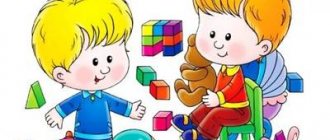Individual educational route for a preschooler as determined by the Federal State Educational Standard
An individual approach to a child’s personality is the basic principle of the Federal State Educational Standard. The principle of priority of the child’s interests was defined by the researchers as “being on the child’s side.” The reason for the difficulties experienced by a child in development should be sought both in the personality of the child himself and in the adults around him, who are directly responsible for the social environment in which the little person grows up. In real life, the child is often the only one on his side. At the same time, he often turns out to be helpless and defenseless in the face of circumstances, so it is important in any problematic situation to hear the child, understand and help him.
The foundation of the modern standard of preschool education was based on the principle of pedagogy of an individual approach and the developmental concept of education. Indicated in the following paragraphs:
- clause 1. 6. - formulation of tasks that concentrate around the creation of optimal conditions for the formation and development of the child’s personality, as well as the disclosure of his creative potential in accordance with his age, psycho-emotional and physiological characteristics, individual abilities and inclinations, and the specifics of the social environment. The child is considered as a valuable subject of relationships with himself, the people around him and the outside world.
- clause 1. 4. - contains the principles of the Federal State Educational Standard, the key of which is the provision on the implementation of an individual approach to the educational needs of each child.
- paragraph 2. 10. 2. - the methods of organizing and coordinating children's initiative and spontaneous activity in the spirit of creative activity are clarified.
- clause 3. 2. 1. - professional selection of forms and methods of pedagogical work that are relevant to the age and individual needs of the child.
- clause 3. 2. 3. - patronage of the child, development of an individual development roadmap, pedagogical and psychological correction of identified problems.
- paragraph 3. 2. 5. - a developmental concept of education aimed at the short-term development of the student.
An individual approach refers to the management of a child’s development, based on a deep, multifaceted study and understanding of the complexity of his inner world and social conditions of life.
Identification of capable children is carried out on the basis of observation, communication with parents, study of individual characteristics
The principle of individual approach pedagogy is not to change the content of education in the interests of a particular child, but to adapt pedagogical methods and techniques to his personal characteristics. For the educational process to be successful, it is necessary to take into account the difficulties that the child experiences and the pace at which he acquires knowledge, skills and abilities. In this case, a model of fruitful partnership between a child and a teacher is being implemented, since the child and parents retain the right to choose the most suitable educational methods from those proposed by specialists.
An individual educational route is a personal way to realize the intellectual, emotional, spiritual potential of a preschool child’s personality. The goal is to create favorable conditions that stimulate activity and the development of the child’s creative and intellectual powers. The teacher’s task is to ensure a competent professional selection of the content of educational, psychological and physical activity, as well as forms and methods of work that meet the individual needs of the child.
Video: individualization of preschool education
Criteria that determine the objectives of an individual development strategy:
- the current level of development of the child’s abilities;
- the degree of his readiness for educational activities;
- individual educational goals and objectives for the near future.
Personal experience in implementing an individual educational route in a preschool educational institution
An individual educational route is an educational activity based on the individual characteristics of each child, where the child himself becomes the subject of education. The individual educational route is determined by the educational needs, individual abilities and capabilities of the preschooler (level of readiness to master the program), as well as existing standards of educational content.
Upbringing and social environment form an individual personality, which is manifested in the direction of abilities, needs, goals, feelings, will and character. Taking into account these abilities, the teacher must approach children individually.
MADOOU No. 20 “Combined Kindergarten” has been operating on individual routes for the second year. When creating an individual route, we used monitoring (which included all areas of the Federal State Educational Standard for Education). Our individual itinerary includes the following components:
setting goals, determining the objectives of educational work.
selection of program material content.
determination of the used pedagogical technologies, methods, systems of training and education, taking into account the individual characteristics of the child.
formation of expected results, deadlines for their achievement and criteria for assessing the effectiveness of implemented activities.
Based on the monitoring, each student of a preschool educational institution can trace poorly developed integrative qualities that needed to be focused on. Taking into account the characteristics of children, we approach each child individually. We have diversified upbringing, education, and training with methods and means of an individual approach, using the most effective ones for the development of each child.
For each problematic criterion, a work plan for the academic year was drawn up. Each month, an area of development with problematic components is reviewed. In order for individual work to be effective, we identify and characterize the characteristics of the child’s development, which allows us to use certain forms, methods and means of individualized influence on the child. A detailed description of classes and conversations is compiled, and methodological literature that is constantly in the group is used. For the convenience of conducting classes and for recording the results of work, a “Schedule of activities for problematic components” is compiled.
When working on individual routes, we most often use the game form. The game occupies a strong place in the system of physical, moral, labor and aesthetic education of preschool children. The essence of play as a leading type of activity is that children reflect in it various aspects of life, the characteristics of relationships between adults, and clarify their knowledge about the surrounding reality. Play is a kind of means for a child to learn about reality. In play, a child learns to subordinate his behavior to the rules of the game, learns the rules of communication with people, develops his mental abilities, cognitive interests, and acquires communication skills. A child who did not finish playing as a child will have a more difficult time establishing contacts with other people. Than children who have rich life experience playing together with peers. During play activities, the individual characteristics of children clearly manifest themselves.
Considering the educational significance of the game, we mean the game as a form of education, as a means for solving certain educational problems in relation to preschool children. Meanwhile, even in educational pedagogical literature, play in its pedagogical meaning is often confused with play as an age-related manifestation of a child. Play as a child’s activity develops according to its own laws.
In working on an individual educational route, we offer students imaginary situations: creative games, amateur games, role-playing games, didactic games, games with rules.
Play in an individual route is characterized by integrity from the motive to the method of action (the child plays because he wants it, he plays what he wants, and plays the way he wants). It is characterized by emotional intensity, pleasure from the process, and not from the result. It develops and changes forms as it develops (from expanded external objective activity to collapsed internal activity).
In the Federal State Educational Standard for Preschool Education, play, along with cognitive, research and creative activity of the child, is declared the main form of program implementation.
The game in the content of the Federal State Educational Standard for Preschool Education includes the conditions necessary for creating a social situation for the development of children that corresponds to the specifics of preschool age.”
The most important part of the work of an individual educational route is the successful development of the child, which means the successful formation of target guidelines, that is, the actual implementation of the Federal State Educational Standard for Education.
Thus, individual educational work on mastering the content of educational areas should be based on or include a sufficient range of games organized on the initiative of an adult, as well as traditional games with content of a corresponding focus.
In our work “every child has the right to independence”, we widely introduce new forms and methods of upbringing and education, and provide an individual approach to each child.
Literature:
- Order of the Ministry of Education and Science of the Russian Federation (Ministry of Education and Science of Russia) dated October 17, 2013 N 1155 Moscow “On approval of the federal state educational standard for preschool education” [Electronic resource]: Access mode www.rg.ru/2013/11/25 /doshk-standart-dok.html.
- Vygodsky, L.S. “Game and its role in the mental development of a child” [Text] / L. S. Vygodsky // Reader on child psychology: from baby to teenager. Textbook ed.comp. k.p. G. Ts. Bumenskaya - ed. 2nd. - M.: 2005-228s.
- From birth to school. Approximate general educational program for preschool education / Ed. N. E. Veraksy, T. S. Komarova, M. A. Vasilyeva. - 2nd ed., revised - M.: Mozaika-Sintez, 2014. - 336 p.
- Smirnova, E. O. Features of communication with preschoolers: a textbook. - M., 2000–198s.
- Seminar “Targets of the Federal State Educational Standard for Educational Education as social and normative age characteristics of a child’s possible achievements”
- Tveritina E. N. Management of children's games in preschool institutions. - M.: Education, 2006. - 112 p.
Algorithm for developing an individual educational route for a child.
1. Algorithm for developing an individual educational route for a child.
On January 1, 2014, Order of the Ministry of Education and Science of the Russian Federation of October 17, 2013 No. 1155 “On approval of the federal state educational standard for preschool education” came into force, which approves the principles of preschool education, including the principle of constructing educational activities based on the individual characteristics of each child , in which the child himself becomes active in choosing the content of his education, becomes the subject of education; the principle of assistance and cooperation between children and adults, recognition of the child as a full participant (subject) of educational relations.
One of the ways to implement these principles in practice is to draw up and implement an individual educational route (IER).
Often, in practice, the process of teaching and upbringing is focused on the average level of development of the child, so not every student can fully realize his potential, and even more so a child who has certain difficulties in learning, communication, etc. This sets the task for the teacher of a preschool educational institution to create optimal conditions for the realization of the potential capabilities of each pupil. The development and implementation of IOM is the optimal solution in this situation.
Algorithm for creating an individual educational route
1. Examination of children (diagnosis), analysis of the state of their mental and physical development, identification of individual characteristics.
2. Setting goals and defining educational objectives.
3. Determining the validity period of the route.
4. Selection of the content of the educational route.
5. Determination of likely implementation results.
6. Interim diagnostics of current results and possible correction of the individual educational route.
7. Summing up the work.
1st stage -
stage of diagnosing the level of development of the pupil’s abilities and his individual characteristics. There are many methods for diagnosing the level of development of abilities and giftedness. These include pedagogical (educational) methods, speech therapy, and psychological (Stanford-Binet, Wechsler tests), questionnaires for parents, the test “Is there a child prodigy living with you?”, the “Assessment of General Giftedness” method, the study of medical documents (diagnosis and doctors' testimony), etc.
At this stage, the characteristics of the physical, mental development, personal and cognitive sphere of the child are identified: the identification of individual psychological characteristics, the identification of learning difficulties, the determination of the level of actual development; recording the nature of developmental deviations, identifying personal resources, determining the zone of proximal development. And the most important thing is to identify the causes of the child’s difficulties.



